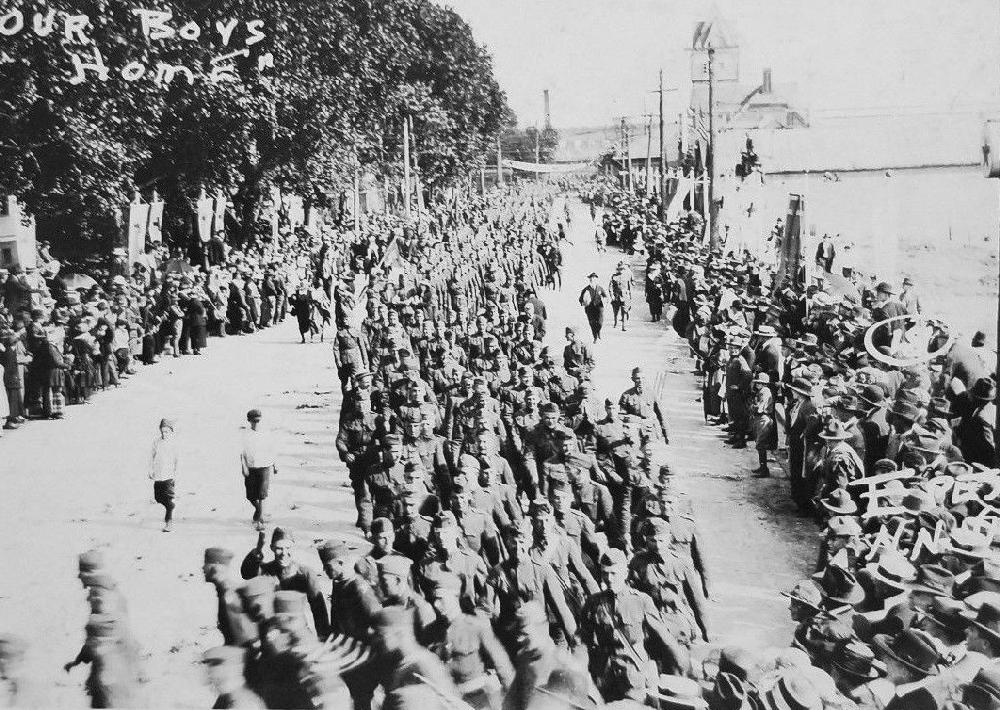
World War I United States: Bringing the Boys Home--Welcome

Figure 1.--Here we see a home town parade welcoming 'Our boys home' some where in the United States. Unfortunately the town is unditebtified. These parades took place all over the country throughout 1919. This was possible because so much of the AEF was National Guard divisions consisting of men from the state and local connunities.
|
|
The doughboys were ethusiastically welcomed home as heroes. There were both dockside homecomings and the Main Street parades, The men were met with jubilent crowds in New York and other port as well as parades in their home towns. There were ticker-tape victory parades, marching bands, speeches, and the good will of a grateful nation.
The biggest parades were the ticker-tape parade in New York City. New York of course was a majport point to disembarkation for the troop ships bringing the boys home. It was hardly, however, the only port. The returning soldiers were also disembarked at Boston, Newport News, and other ports. There were also massive home-town parades throughout the country. This was possible because much of the AEF was state-based National Guard divisions. Congress just before anerica entering the war reformed the state militias into the new National Guard (1916). And when activated the National Guard formed many of the AEF divisions. This mean that the men in those divisions virtually all came from the same state with many men from the same local communities. And the men, unlike World War II, were returned home by divisions. This meant that much of the returning AEF returned to their states and communities all at the same time, making possible massive state and local celebrations. A good example is the 30th Division. It was a unit of the Army National Guard in both World War I and World War II. The 30th was nicknamed the 'Old Hickory' Division, in honor of President Andrew Jackson. A web page about the 30th drawn from a vet's journal reads, "Twenty-eight thousand troops, including much of the 30th, came home aboard the USS Finland throughout 1919. The postwar port of disembarkation for the 30th was Newport News, Virginia. Traveling by train, it was on to Knoxville, Nashville, Memphis and Chattanooga where great celebrations were staged to honor the veterans. The welcome parade in Knoxville drew 30,000 people. Other, smaller towns saluted the troops with similar enthusiasm. In Nashville, a miniature Arc de Triomphe was constructed near the Capitol and the reception was overwhelming. At the end of his journal, Frierson, in capital letters, wrote 'NO MORE WAR FOR ME', a sentiment shared by tens of millions throughout the world."
CIH

Navigate the CIH World War I Pages:
[Return to Main bringing the boys home page]
[Return to Main American mobilization page]
[Return to Main AEF page]
[Return to Main U.S. Army page]
[Return to Main America enters World War I page]
[Return to Main U.S. World War I page]
[Aftermath]
[Alliances]
[Animals]
[Armistace]
[Causes]
[Campaigns]
[Casualties]
[Children]
[Countries]
[Declaration of war]
[Deciding factors]
-------[Diplomacy]
[Economics]
-------[Geo-political crisis]
[Home front]
[Military forces]
[Neutrality]
[Pacifism]
[People]
[Peace treaties]
[Propaganda]
[POWs]
[Russian Revolution]
[Signals and intelligence]
[Terrorism]
[Trench warfare]
------[Technology]
[Weaponry]
[Bibliographies]
[Contributions]
[FAQs]
[Images]
[Links]
[Registration]
[Tools]
[Return to Main World War I page]
[Return to Main war essay page]
Created: 6:04 AM 2/23/2017
Last updated: 6:04 AM 2/23/2017



